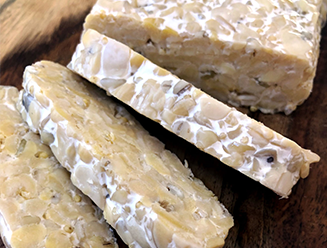It is now well known that soy is a food with interesting nutritional value, attributable in particular to the quality of its proteins, its good fats (monounsaturated and polyunsaturated), as well as its content rich in minerals and various phytochemicals. , including phytosterols, which are beneficial for heart health.
While tofu is gaining more and more followers in Quebec, tempeh remains a little-known product. However, this nutritious food offers an excellent opportunity to vary your consumption of meat substitutes and to discover a new panoply of flavors.
The making of tempeh
Native to the island of Java in Indonesia, tempeh is a product made from fermented soybeans, to which cereals can be added.
To obtain this kind of whitish pâté, whole soybeans are cooked, crushed into a pancake, and seeded with a mushroom (Rhizopus oligosporus). Tempeh is thus obtained through a fermentation process, during which mold forms at a controlled temperature, as is the case with some cheeses.
Its earthy taste, its mushroom and hazelnut aromas and its firm, crunchy and tender texture will surely surprise you! Available in different varieties (plain, with seaweed, or including certain grains or cereals), there is something for everyone.
A nutritional value as interesting as tofu, if not more!
Tempeh is a protein food made from soy, just like tofu. They both contain proteins “of high biological value”, that is to say, having all the essential amino acids. Therefore, these foods are an excellent source of vegetable protein.
What distinguishes tempeh from tofu is its high bioavailability of several nutrients, obtained in large part through the fermentation process. Containing 3g of fiber per 100g, tempeh is a source of dietary fiber, unlike tofu which contains no fiber. Plus, in equal portions, tempeh contains 20% more protein, triple the potassium and copper, and double the phosphorus and magnesium than firm tofu. It also contains more good monounsaturated and polyunsaturated fats and vitamins, such as niacin and vitamin B12, which are essential for the health of your cells and nervous system.
However, the amount of bioactive vitamin B12 in tempeh appears to be limited and is not comparable to that found in animal products (meat, eggs, milk, fish). Vegetarians should therefore make sure to consume products fortified with vitamin B12, such as fortified soy beverages, certain fortified yeasts or imitation meat products marked “meat” on the packaging.
Moreover, if we opt for a version also containing cereals, we have a product that is even more nutritious and rich in fiber.
Fermentation maximizes the nutritional value of tempeh
Fermentation of legumes (soybeans in this case) is a manufacturing method that offers several advantages.
As is the case with fermented soy products (tamari sauce, miso), the soybeans used in making tempeh are fermented, which produces enzymes that increase the digestibility as well as the nutritional value of this product.
The fermentation process also causes an increase in certain amino acids, which improves the biological value of the proteins contained in tempeh, compared to those contained in tofu.
In addition, this process produces a reduction in certain antinutritional factors naturally contained in raw legumes, such as phytates or antitrypsic factors, which are liable to cause certain undesirable effects. The result : improved bioavailability of some vitamins and minerals, as well as better protein digestibility.
How to prepare it?
A great substitute for meat in many dishes, tempeh must be cooked before eating. Traditionally served as a stir-fry with vegetables, this versatile food can also be grilled, marinated, chopped or incorporated into sauces once it’s cooked. In short, the possibilities are endless.
Like tofu, tempeh tastes better when marinated or seasoned. Why not try marinating it in your favorite marinade and simply grilling it to make an express burger, sandwich or veggie salad?
A sweet and savory sauce is also great for enhancing the flavor of the tempeh. Simply mix these ingredients together using a hand blender or whisk: 1/2 cup nutritional flake yeast, 1/4 cup water, 2 tablespoons olive oil, maple syrup and tamari sauce and 1 minced garlic clove. In a large bowl, add strips of cooked tempeh on a bed of cooked brown rice, then garnish with various vegetables and this sauce. Delight guaranteed!
If you are not used to eating tempeh, you may find it tastes rather bitter. The solution? Boil it for ten minutes before preparing it. You can easily marinate and grill it once it is boiled.
Where can I get it?
Tempeh can be found in the organic row freezers of many health food supermarkets and grocery stores. Once thawed, it can be stored in an airtight container for 5 days in the refrigerator.
The fresh tempeh has a mushroom smell and is covered with a thin whitish layer.
All the more reason to try this product: tempeh is made in Quebec. In addition to being nutritious, its consumption is therefore a good way to eat local and to encourage producers here.
Source article (in French) : https://www.extenso.org/article/le-tempeh-un-substitut-de-viande-a-decouvrir/





